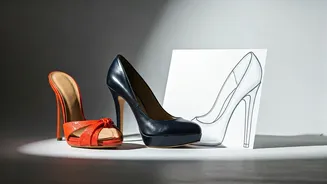Design Copying Unveiled
The fashion world, often celebrated for its creativity, isn't immune to controversies. One such instance recently unfolded when a UK animator publicly
accused a well-known Indian shoe brand of stealing their design. The animator, upon discovering their creative work being replicated, brought the issue to light. This action ignited a wave of online discussion and highlighted the complex ethical considerations surrounding intellectual property within the industry. The impact of such accusations extended beyond just the involved parties, prompting a broader examination of originality and ownership in fashion. The incident demonstrated how swiftly information can circulate, and how public opinion can influence the resolution of design theft issues.
The Backlash Response
Following the accusation, the public's reaction was swift and critical, as social media platforms became central to the discourse surrounding the design theft. This intense scrutiny prompted a response from the Indian shoe brand's creative director. Acknowledging the issue, the director issued a public apology, expressing regret for the situation. This acknowledgment showcased the potential of online pressure in situations of design plagiarism, prompting the brand to take responsibility. The apology, although a step toward reconciliation, also served as a reminder of the need for ethical conduct in the industry. It was a clear demonstration of how reputations can be damaged and the importance of addressing accusations promptly.
Impact and Ramifications
The episode highlights the significant consequences of design theft for both the original creators and the accused. For the UK animator, the theft of their design represented a violation of their intellectual property. The act of copying not only undermined their creative effort but also potentially hurt their brand's value. The incident highlights the emotional and financial implications of design theft on the creator's end. Furthermore, for the Indian shoe brand, the accusations resulted in damage to its reputation. The incident can diminish consumer confidence and create distrust. The ripple effect of the accusations emphasized the crucial need for companies to respect intellectual property and demonstrate transparency in their practices. It also raised questions about the steps the brand took to ensure the originality of its designs.
Lessons for Industry
The incident involving the Indian shoe brand serves as a valuable lesson for the fashion industry regarding intellectual property protection and the ethical considerations surrounding design originality. The case underscores the significance of conducting thorough research and due diligence to avoid accidental or deliberate plagiarism. Additionally, the episode encourages designers and brands to create and implement robust intellectual property policies, offering protection for their creative work. It highlights the importance of fostering a culture of respect for creativity and innovation. Embracing these practices can help prevent similar incidents and maintain the integrity and credibility of the fashion industry. The focus on originality is essential for the sustainable success of design houses and brands within the fashion space.
Looking Ahead
In the aftermath of the design theft accusation, the fashion community has a chance to reflect on the importance of original design and creative ownership. Moving forward, it is essential that all industry participants focus on transparency, ethical conduct, and respect for the intellectual property rights of others. Designers and brands should emphasize innovation. They should use this incident as a catalyst for reform within the industry. Implementing clearer processes for design authentication and enforcing stricter penalties for plagiarism can help prevent similar incidents. Furthermore, the incident serves as a reminder to consumers to support brands that prioritize originality and integrity. By doing so, they encourage a healthier, more creative, and ethically conscious fashion ecosystem.
















